CROCODILIANS Family Crocodylidae
Crocodiles, alligators, caimans and relatives
I am fascinated by Crocodilians -- one of the world's most ancient vertebrate
families -- but at a safe distance. Fortunately, telephoto lens help close
the distance. I've only photographed three species adequately, two in Florida
and one in Africa, and a gallery of these photos is presented here. Unlike
birds, I am just casually interested in these reptiles -- enjoying them
immensely but not feeling compelled to know that much about them. A January
1978 National Geographic article [R. Gore, photos by J. Blair, "A
bad time to be a crocodile"] illustrates 21 crocodilian species worldwide,
many of them endangered. Possibly that information is generally in the
ballpark. All photos © Don Roberson; all rights reserved.
AMERICAN ALLIGATOR

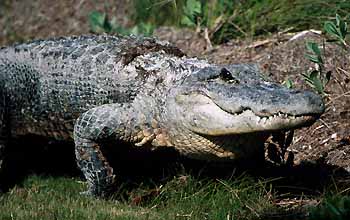
The
American Alligator Alligator mississipiensis is resident
along the Gulf Coast of North America. Once hunted to threatened status,
it has come back well with protection and is now easily found from Texas
to Florida. All these photos were taken in Jan 1999 in Everglades National
Park, Florida. I've never seen an alligator as far out of the water as
the adult which walked by me (much too close!; middle left). I pictured
it as a female heading off to her nest; I'm told they can move quite fast
if need be. One truly feels prehistory when watching alligators.
The baby alligator (bottom right) was floating along
Anhinga Trail where I photographed it from a boardwalk. It is rare to see
different sized alligators in the same spot since big ones will eat little
ones.
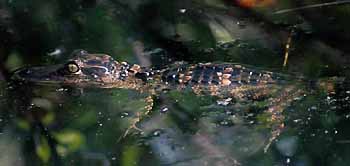
AMERICAN CROCODILE
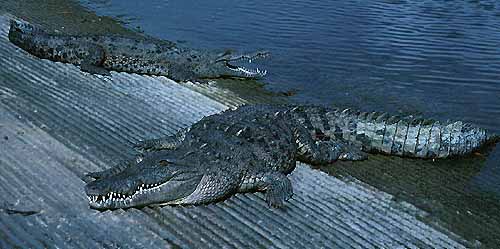
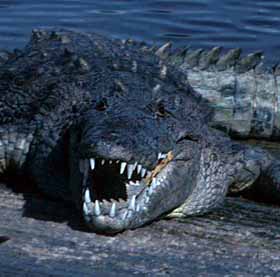 The American Crocodile Crocodylus acutus is now an endangered
species, ranging around the Caribbean to southern Florida, in the Greater
Antilles, and Colombia & Ecuador. It is essentially restricted to saltwater
near shore -- estuaries and mangroves. Only a few hundred remain in Florida,
and I was absolutely delighted to find the large one and the small one
sunning on a boat launching ramp at Flamingo, Everglades National Park,
in Jan 1999. It is so rare I always assumed it would take a dedicated search
over many days to find the American Crocodile.
The American Crocodile Crocodylus acutus is now an endangered
species, ranging around the Caribbean to southern Florida, in the Greater
Antilles, and Colombia & Ecuador. It is essentially restricted to saltwater
near shore -- estuaries and mangroves. Only a few hundred remain in Florida,
and I was absolutely delighted to find the large one and the small one
sunning on a boat launching ramp at Flamingo, Everglades National Park,
in Jan 1999. It is so rare I always assumed it would take a dedicated search
over many days to find the American Crocodile.
Easy separating points between the Crocodile (here) and the Alligator
(prior set) include the visible teeth extending from both jaws on the crocodile
(only from the upper jaw in the alligator); the paler greenish-gray color
with big blotches (compared to darker blackish when wet color of alligator,
which lacks the blotches); the much narrower and longer snout of the 'croc;
and the less upturned "smile line" of the crocodile.
NILE CROCODILE
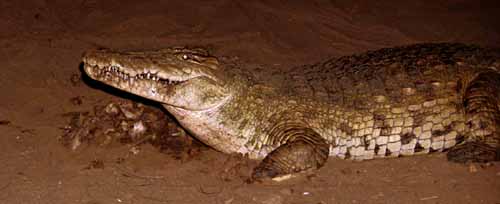
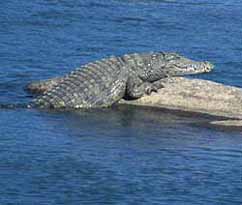
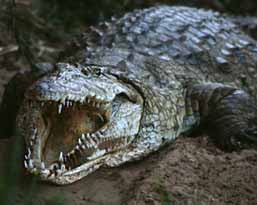
The Nile Crocodile Crocodylus niloticus is common along
the large rivers and in the lakes of Africa. It is a major reason to avoid
swimming in Africa. They can be amazingly fast, but most of the time one
sees them just lazing on a log or sandbank, like the beast at lower left
in Kruger Nat'l Park, South Africa (July 1996). Sometimes they seem to
doze with their jaws agape, as the one lower right along the Uaso Nyiro
River in Samburu Nat'l Park, northern Kenya (Nov 1981). Indeed, at nearby
Samburu Lodge, Nile Crocodiles would routinely come to eat at the "crocodile
bar" just below an outdoor patio where the staff tossed-out leftovers from
dinner. The upper croc is enjoying such a meal within a few feet of where
we were enjoying our Tusker Premium beers in Nov 1981.
Although early African explorers saw awe-inspiring sights of huge aggregations
of the monster reptiles, Nile Crocodiles have been persecuted throughout
Africa and now exist in numbers only in reserves; I understand that the
aggregations in Murchison Falls Nat'l Park, Uganda, can still be impressive.
There is a great PBS film -- "Last Feast of the Crocodiles," I think it's
called -- about the effect of drought on Nile Crocodile life along the
Luvuvhu River in South Africa. It has spectacular footage of both crocs
and many of the local birds and mammals.
TOP
RETURN TO HERP
PAGE
GO TO LIST OF FAMILIES
OF THE WORLD
GO TO BIRDING THE
WORLD PAGE
RETURN TO HOME
PAGE




 The American Crocodile Crocodylus acutus is now an endangered
species, ranging around the Caribbean to southern Florida, in the Greater
Antilles, and Colombia & Ecuador. It is essentially restricted to saltwater
near shore -- estuaries and mangroves. Only a few hundred remain in Florida,
and I was absolutely delighted to find the large one and the small one
sunning on a boat launching ramp at Flamingo, Everglades National Park,
in Jan 1999. It is so rare I always assumed it would take a dedicated search
over many days to find the American Crocodile.
The American Crocodile Crocodylus acutus is now an endangered
species, ranging around the Caribbean to southern Florida, in the Greater
Antilles, and Colombia & Ecuador. It is essentially restricted to saltwater
near shore -- estuaries and mangroves. Only a few hundred remain in Florida,
and I was absolutely delighted to find the large one and the small one
sunning on a boat launching ramp at Flamingo, Everglades National Park,
in Jan 1999. It is so rare I always assumed it would take a dedicated search
over many days to find the American Crocodile.


